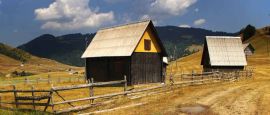Getting around Montenegro
Montenegro is a small country with no internal flights between its two airports, Podgorica (TGD) and Tivat (TIV).
Montenegro boasts a network of roads connecting major cities, coastal areas, and mountainous regions. The Adriatic Highway (E65/E80), which runs along the coast, is a major route.
Main roads are well signposted, but having a GPS device or a reliable map is beneficial, especially in remote regions where navigation can be tricky. Fuel stations are readily available in urban areas but become sparse in rural zones. During the summer months, coastal roads can experience heavy congestion due to the influx of tourists, whereas inland routes tend to be less crowded. Defensive driving and adherence to local traffic laws are essential for a safe and smooth journey.
Montenegro's main roads, including highways and coastal routes, are generally well-maintained and suitable for most vehicles. However, rural and mountainous roads can be narrow, winding, and occasionally in poor condition, particularly in winter when snow and ice pose additional challenges. Some roads lack guardrails, and landslides may occur in certain areas. While road conditions have improved significantly in recent years, drivers should remain cautious, especially on less-travelled routes.
Car rental services are available in cities like Podgorica, Tivat, Budva, Kotor, and Petrovac, with prices varying by season. During peak tourist months (June to August), rates are higher due to increased demand, while off-peak periods offer more affordable options.
In Montenegro, the minimum age to rent a car is typically 21, and a valid driving licence must be held for at least two years. Drivers aged 19 or 20 may be eligible to rent a vehicle by paying an additional young driver fee, though this option is limited to certain car categories.
Main cities have metered taxis, which are reasonably priced, though foreigners are sometimes charged higher rates. It is possible to negotiate a fare when the meters are not in use. Only use officially marked taxis.
The EuroVelo 8, also known as the Mediterranean Route, traverses Montenegro, offering cyclists a chance to explore the country's stunning Adriatic coastline. This route is part of a larger network connecting various European countries along the Mediterranean Sea.
Montenegro's topography is predominantly mountainous. Therefore, it offers several marked mountain biking trails that cater to different skill levels. Notable routes include "Salty and Sweet", a 629 km trail combining asphalt and macadam surfaces, and "North Discoveries", spanning 390 km through diverse terrains.
Montenegro's long-distance bus services offer an affordable and efficient way to explore the country's diverse regions. Popular routes include:
• Podgorica to Kotor
• Podgorica to Budva
• Kotor to Budva
• Podgorica to Herceg Novi
• Podgorica to Bar
These routes are well-serviced, with buses departing several times a day, especially during peak tourist seasons. Tickets can be purchased at bus stations, directly from the driver, or in advance. For detailed schedules and booking options, see Busticket4.me.
In Montenegro, speed limits are set at 50 km/h (31 mph) in urban areas, 80 km/h (50 mph) on rural roads, and 100 km/h (62 mph) on expressways, though drivers should always follow posted signs as limits may vary.
Seat belts are mandatory for all passengers, and children under five must be secured in an appropriate child seat, while those under 12 are not allowed to sit in the front. The legal blood alcohol limit is 0.3 grams per litre (0.03%), and violations can result in fines, licence suspension, or imprisonment.
Dipped headlights must be used at all times (both day and night), and using mobile phones while driving is prohibited, though hands-free devices are allowed.
From November 15 to April 1, winter tyres are required, and snow chains must be carried when driving in mountainous areas during heavy snowfall. Vehicles must also be equipped with a warning triangle, a first aid kit, a reflective vest, and a set of spare bulbs.
The Automobile Association of Montenegro (AMSCG) offers 24/7 support, including towing and repair services, across all major routes and cities. The contact of AMSCG is +382 (20) 19807.
Foreign drivers in Montenegro must carry a valid driving licence from their home country. While Montenegro accepts EU licences, an International Driving Permit (IDP) is recommended, especially if your licence is not in English or Montenegrin. Additionally, it's essential to have the vehicle's registration documents and proof of insurance readily available. Montenegro recognises EU "Green Card" insurance; however, for extended stays, obtaining local insurance is advisable.
In Podgorica, residents and visitors typically rely on a combination of public buses and taxis for urban transportation. The city maintains 12 bus lines and 16 suburban routes, ensuring comprehensive coverage.
In Budva, Bar, and Kotor, most people get around on foot, as many attractions, shops, and restaurants are within walking distance.
Taxis are also a common mode of transport, offering a convenient alternative to buses. Several reputable taxi companies operate in major cities like Podgorica, Kotor, and Budva.
In Montenegro, domestic train travel is available but not the primary mode of transportation for most residents. The country's rail network centres around the Bar to Bijelo Polje line, which traverses the nation from the Adriatic coast to the northern border with Serbia. This route offers several daily services, with stops in key cities such as Podgorica, Kolašin, and Mojkovac. Travellers should note that train schedules can vary, and services may be less frequent during off-peak seasons. Therefore, it's advisable to consult the latest timetables and plan accordingly.
Do you have any Feedback about this page?
© 2025 Columbus Travel Media Ltd. All rights reserved. No part of this site may be reproduced without our written permission, click here for information on Columbus Content Solutions.




 You know where
You know where